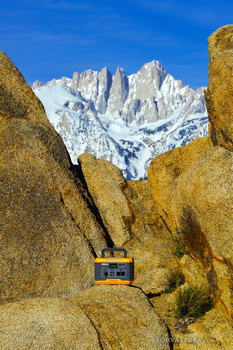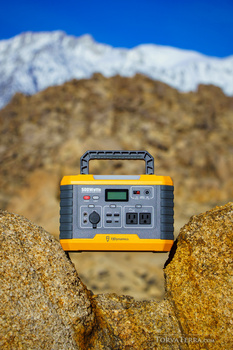When it comes to traveling as a nature photographer, one trouble spot comes up: charging. I recently fell down the rabbit hole of portable power stations, and let me share with you the difference a good power station makes for the road-tripping photographer.
With the type of photography that I do, wildlife and landscapes, I am often in remote places or on the go for days to weeks at a time. Whether it be hiking, camping, or just not having enough downtime to charge all of my devices, the reliance on battery power is real. It is no fun having to find a town with a coffee shop to sit at just to charge your batteries on a road trip. In researching portable power stations, they can be pricey, and there are a lot of options. Recently, Fstoppers was given the opportunity to try out the FJDynamics power station, and I jumped on the chance to bring it camping. Let me share my thoughts with you, both on this specific device and some tips in general that I learned about power stations.

First Impressions
The FJD 500W Portable Power Station MP500 gave me a good first impression, arriving in a nice foam-padded box that even has a carry handle. So, of course, I kept the box for storage when not in use. The power station comes with an AC charging adapter, car charging cable, an MC4 to DC7909 cable, and user manual. It even has a built-in flashlight. The features drew me in. An aspect of this power station that most set it apart for me is its small size for camping and the ability to wirelessly charge. A lightweight device and a reduction in cables I need to carry are big deals when on the go.


Stats and Features
Item Dimensions: 11.4 x 7.5 x 7.9 inches
Item Weight: 14 lbs
Power Source: AC, Solar Panel, Car Port, Generator
Voltage: 110 volts
Wattage: 500 watts
Ports: MP500 has 2*pure sine wave AC outlets (110v, rated 500 W), 2*DC ports (112 W), 1*cigarette lighter socket port (112 W), 2*QC3.0 USB(18 W), and 1*Type-C PD (60 W), 1*wireless charge output.
Safety Features: Overload Protection, Short Circuit Protection, Overcurrent Protection, Over-voltage Protection, Battery Balance System
As far as charging, the power station can be charged via AC wall outlet in 4 hours, solar power in 5 hours, or with the car charger in about 7 hours. FJDynamics does offer solar panels separately, but I haven’t tried those. Solar panels are an option to think about for charging when you won’t be by an outlet or car anytime soon. The unit arrived at 50% battery, so I started out by charging it on the AC wall outlet. It took a little less than 2 hours to get to 100% (from that out of the box 50%), as predicted. Fast charging is the most important feature, which gets a checkmark from me.


Because I road-trip and car-camp a lot, the car charging ability is a game changer. I found that starting with a full charge from wall AC, I could supplement or top off the battery as needed with the car charger. It also has pass-through. so I could charge the device while using it to charge my camera batteries.
That being said, I could go days almost a week at a time and not need to recharge the power station depending on use. It is rated at 40 full phone charges off a full charge. I supplemented it to keep it full in case of emergency. And emergency is another aspect of why the power station is not only a quality of life improvement but a great safety device to have. If I ever get stranded in the middle of nowhere, I know that I have this extra battery power. That peace of mind is worth a lot!
In the Field
In practical use, I ended up using the charger to keep my phone, camera batteries, and laptop charged. It was so nice to have. In the past, I would use a little car charger to charge my phone and go into town for lunch periodically to charge my camera and laptop. I would be stuck for hours at a random café or restaurant to keep my devices charged. What a world of difference having the power station. It added an extra layer of freedom to my adventures and let me stay out for longer and go farther into the wilderness. So, I can definitely recommend having a power station if you like to roadtrip, camp, as a backup on your photo shoots, or simply in case of emergency.
For testing the FJD 500W Portable Power Station, I took it on my superbloom road trip across Arizona, California, and Utah. I found it to be a big help when I was out in wilderness areas camping looking for rare wildflowers. I even brought it rock scrambling just for fun and to give you all a taste of how easy it is to bring around wherever you might need it, even if where you need it is when you're perched up on some boulders in the mountains.

Solving Your Charging Woes
So, why didn’t I get a power station sooner? I don’t really see them mentioned often in the photography world, and it wasn’t until I got more into the big extended camping trips that I started learning about solving my charging issues. So, I think that the barrier to entry for accessories like this is first not knowing they exist, not being sure which to get to suit your needs, or price. Having researched a bit, for our uses as photographers, the main aspects to look for are overall size, weight, charging times, and features. In comparison to contemporaries, the FJDynamics power station stands out as smaller, roughly the same or lighter in weight, with more features like the wireless charging and light, and finally, much faster in charging. Most other 500 W power stations take 7-9 hours to AC charge, and the FJD 500W Portable Power Station MP500 only takes four hours. It is a solid answer to solving a common issue, charging on the go, or in emergency.

The only downside I have found to portable power stations, and this goes for all types and brands, is flying. Currently, FAA regulations state that you cannot bring a power bank or station over 100 Wh on a plane. I ended up having to ship my FJD 500W Portable Power Station back home after my road trip via USPS Ground. Not even mail carriers can fly them. Luckily, most of my trips are round-trip road trips, but if I have to fly again, I would continue to ship the power station for my long trips when it makes sense. It is that valuable an item to me to have now. They have spoiled me.

Final Thoughts (Plus Exclusive Discount Code!)
Overall, the FJD 500W Portable Power Station is a great device that worked just as described. It charged quickly, kept me on the road longer, and saved me time in the field by keeping my energy-gobbling devices happy. It was a great tool to add to my list of things that aren’t camera gear but really help make a photographer's life a little (or in this case, a lot) easier. Oh yeah, remember when I mentioned price earlier? In addition to letting me try their MP500 power station so that I could report back my findings to you all, FJDynamics is also offering Fstoppers readers an exclusive $200 discount until June 30th, 2023. So, for $299, you can grab your own FJD 500W Portable Power Station MP500. Just use the coupon code MP500SPR on Amazon. Happy and fully charged travels, friends!










Maybe I don't really understand the article. Could it be that this power plant weighs 14 LB or 6.35 kilograms? Let's leave the price aside. What photographer carries 6.35 kg for days through the mountains, desert or places where there is no power supply but great photo motifs? Almost every photographer complains about every tripod that weighs more than 2 LB. It's always about weight, whether it's the camera or the lenses. And now I'm supposed to carry 14 LB around for days on top of my backpack full of photo equipment and food and tent and clothes? Hmmm ... I must have misunderstood something. So what exactly do I need this power plant for? When I'm travelling by car, I have enough electricity. When I'm on foot, the power plant is clearly too heavy for me, there are much lighter solutions. What scenario am I overlooking that justifies the use of this power plant for photographers?
My experience is based on years of wildlife photography in Namibia and South Africa, not seeing a power point for weeks at a time. My Land Rover powered the computers and the Engel Freezer, charged all the batteries and satellite phones, and as a stopgap, did some quick welding. As long as there was enough fuel, there was electricity.
Hi Studio 4x5! This type of charging is for certain types of travel like conversion vans, car camping, long stay campsites, beach days, emergencies, etc. It is actually an extremely popular market with multiple brands, types and uses. If you Google "portable power station" there is much more info on the options and market itself. For example, I Googled a few popular portable power station brands yearly revenue the top three made $126M, $38.9M, $12.8M USD last year alone.
For me my car is not an overlander, it lacks the ability to charge an AC wall adapter plug. So a small 14lb power station is great for car camping and keeping my devices charged. I also bring it on short hikes and overnights. While this might not work for you and that is totally okay, it is something that has a lot of dedicated users which the market and reviews reflect.
500w, quite enough really